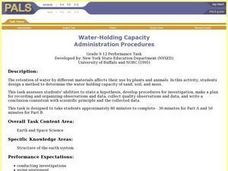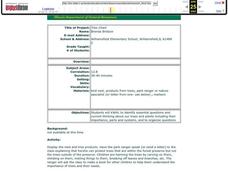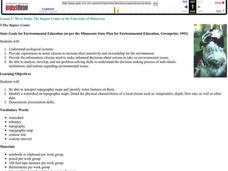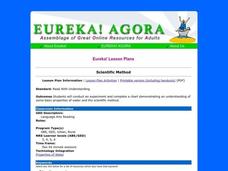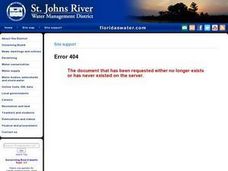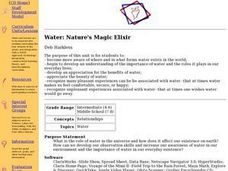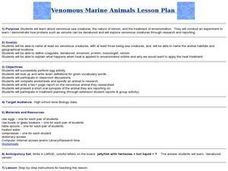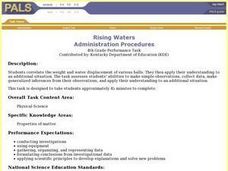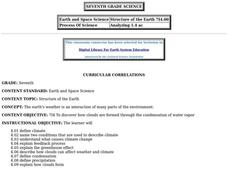Curated OER
Mapping your watershed
Young scholars investigate the importance of watersheds around the world. By visiting resource links, students can locate watersheds and their sources in the USA and Russia and analyze their effects on the surrounding topography. This...
Curated OER
Soap, Wood, and Water
Young scholars measure the properties of two different types of soap and wood and calculate their densities. Then they predict whether or not whether or not each object would float or sink in fresh or salt water.
Curated OER
Density and Buoyancy Experimental Design
Young scholars must plan, design, and conduct an experiment that answers the scientific question: "Come up with a question that addresses the factors (variables) of the water and its effect on whether an object floats or sinks."
Curated OER
Water-Holding Capacity
Learners design and conduct an experiment to compare the water-holding capacity of sand, soil, and moss. They measure the change in weight for each material after adding the same amount of water to each material.
Curated OER
Soiled Again
High schoolers propose and perform an experiment using the scientific method. The purpose of the experiment is to discern some earth materials or combinations of earth materials that best increases the pH of "acid rain". From the results...
Curated OER
Field Work
Students realize that everyone lives in a watershed and that water is a fundamental life sustaining resource, they investigate ways to look at surface streams for quantity and quality of this vital resources. Students construct a...
Curated OER
User-friendly rivers
Students explore and explain their connection to rivers through watersheds. They break into three groups. Each group needs: Blue enamel paint, Miniature objects to simulate a model river system, modeling clay, Tempera paint, Toothpicks...
Curated OER
Tree Chart
students identify questions about trees and plants to include their importance, parts, and systems. They list the things they know, want to know, and how they are going to study it.
Curated OER
River Study
Pupils explore a stream in their area and show the class the topographic map of the stream. They locate the topographic map and name the streams, lakes and ponds in their watershed. They write a paragraph about their stream and complete...
Curated OER
Abundant Lakes
Students define lake life zones. They define stormwater runoff and its effects on lakes. They identify the relationship between decaying substances and water pollution. They construct a freshwater food web.
Curated OER
Scientific Method
Students explore the steps in the scientific methods. Through activities, students discover the scientific is a tool for solving problems of any kind. Students will fill out a scientific method chart, and determine what information is...
Curated OER
Landfills, Leaks and Spills
Students define spills, leaks and landfills. Students list environmental problems caused by spills,leaks and landfills. Students access the Internet to complete Prediction lab report worksheets, etc. Students test/quiz over their...
Curated OER
Nature's Magic Elixir
Students do research to discover the importance of water in the world and its effect upon our daily lives. They will also appreciate the beauty of water and how it is so adaptable within nature.
Curated OER
Venomous Marine Animals
Students name and describe six venomous marine animals. After participating in an activity, they define new vocabulary words. In groups, they complete worksheets to use while researching a specific venomous animal of their choice. ...
Curated OER
Who Dirtied the Water?
Students develop a greater understanding and concern for the plight of our coastal waterways. Students begin to recognize that we are all partially responsible for water pollution.
Curated OER
From Lake to Tap
Students use the Internet to study how water is treated to make it safe to drink. They use a tutorial on the U.S. Environmental Protection Agency's website to gain this information. They complete a worksheet for the assessment portion...
Curated OER
Understanding the Effects of Water Pollution
Third graders examine the effects of water pollution by participating in a story. After reading the story, they determine the best way to get rid of the pollution in a river using different objects. In groups, they complete a worksheet...
Curated OER
TE Activity: Stream Consciousness
Fourth graders study how environmental engineers monitor water quality. They use environmental indicators to determine the quality of stream water in their area. They count the number of macroinverabrates and use the information they...
Curated OER
Creek Monitoring
Sixth graders conduct a variety of assessments at a local stream to determine if it is a suitable habitat for salmon. They measure temperature, tubidity, dissolved oxygen, pH levels, bacteria and nutrients. In this unit, 6th graders work...
Curated OER
Rising Waters
Fourth graders rank balls by size from smallest to largest and from lightest to heaviest and then by how much they made the water rise. They then discuss why certain balls make the water rise higher than do other balls.
Curated OER
Why Is Water So Important to My Community?
Students read and listen to stories and sayings in New Mexico families. Using the text, they discoer the values and beliefs of a culture. They reflect on the meanings of symbols related to water. They discover the importance water has...
Curated OER
King of the Mound
Students investigate water as an agent of change. They conduct an experiment involving a mound of soil, observe and record any changes that occur when ice melts on the mound of dirt, and create a drawing of the changes that take place...
Curated OER
Beans Are Seeds
Second graders read literature regarding the growth of seeds. They investigate how seeds need water and light to sprout and then grow. They experiment by planting their own bean seeds. They record the progress of their seeds in both...
Curated OER
Structure of the Earth
Seventh graders study the cause of climate change, and how clouds form and affect weather. They define condensation and precipitation, the greenhouse effect and the water cycle.





